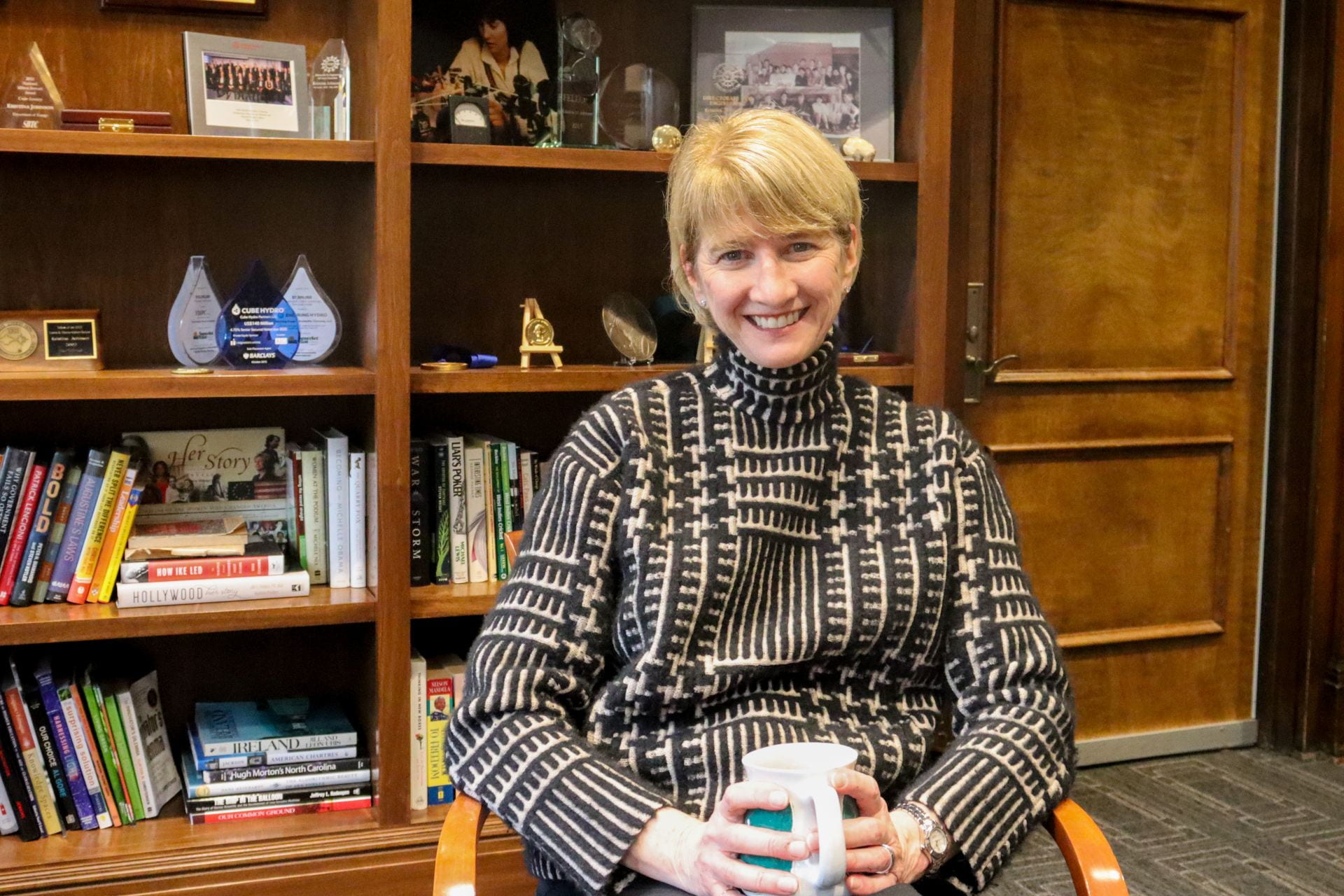
University President Kristina M. Johnson sat down with Lantern reporters to discuss safety, diversifying the university and a debt-free education Wednesday. Credit: Jessica Langer | Campus LTV Producer
As concerns about the COVID-19 omicron variant increase, Ohio State students, faculty and staff may wonder what the spring semester holds.
University President Kristina M. Johnson said administrators are discussing the new variant and are still assessing incoming data to determine what’s next for the university.
In addition to COVID-19, Johnson sat down with Lantern reporters Wednesday to discuss safety, diversifying the university and a debt-free education.
“I’m really focusing on being here and our regional campuses in Ohio, really trying to learn the culture, learn about the communities, see how I can best serve,” Johnson said.
COVID-19 and pandemic precautions
Johnson said the university recommends Buckeyes take advantage of the university’s voluntary COVID-19 test offerings, especially for those who traveled outside of the country for Thanksgiving break.
Johnson also said the university will look at the incoming data on the omicron variant to assess how pandemic protocols on campus might change.
“I think that we all understand that we’re in this together, so I think when the data and the science tell us that we can take our masks off when we’re indoors, we’ll do it quickly,” Johnson said. “I think we still need a little bit more data. There may be ways to do some modification given that we’re over 90 percent in our vaccination.”
Over 92 percent of students, faculty and staff have received one or more doses of the vaccine — including over 91 percent of students and over 93 percent of employees.
Safety
Johnson said she approaches safety on and around campus from multiple angles. She said the university is focused on both preventative safety measures and increasing police presence, which she said is only part of the solution.
“We can also look a bit further and say, ‘OK, so why are these crimes happening? What’s the root cause?’ ” Johnson said. “Part of it is, what are we doing as a university to provide opportunities for those individuals that otherwise might not return to crime?”
Johnson said the university partners with Columbus State for the Science, Technology, Engineering, Arts, Math and Medicine — or STEAMM — program to get elementary, middle and high school students excited about careers in those fields. She said the program is designed to help prevent crime by getting students further involved in academics.
After the introduction of efforts such as increased lighting off campus, cameras and distribution of free safety devices, Johnson said crime was reduced by 60 percent. She said the university uses a heat map of the University District to compare crimes from month to month.
Johnson said even though Ohio State’s campus is very safe, the university will continue to combat off campus crime — which has proved a more significant issue. She said additional safety measures will be introduced in the future.
Diversifying the university
Johnson said the Race, Inclusion and Social Equity hiring initiative — which aims to hire 150 diverse tenure-track faculty in the coming years — is “coming along nicely,” and she expects Executive Vice President and Provost Melissa L. Gilliam to be at the helm of the initiative.
Johnson did not clarify how many tenure-track positions have been filled so far as a result of the RAISE initiative.
“I’m so excited about Melissa Gilliam. I mean, her background, she’s got an arts background, she’s got an English background, she’s got medical, scientific background,” Johnson said.
Johnson said the number of students over the past 12 years has increased while the number of tenure-track faculty has decreased. She hopes to reverse this trend by hiring a minimum of 350 new faculty over the next decade — which will reflect the demographics of the current campus.
When a new president comes in, Johnson said it is important to assess goals surrounding the culture of the university.
“It was important to work on the safety and health of our students, faculty, staff,” Johnson said. “At the same time to start thinking about getting to know the culture, and then you want to think about, ‘OK, given the resources we have and what can be done,’ you know, ‘Who are the leaders that we can build a team around in order to move forward?’ ”
Johnson said she hopes to create a welcoming and supportive environment for everyone on Ohio State’s campus.
“I would say I’m supportive of all our students,” Johnson said. “All that I want them to be, as I said in my investiture speech, the best possible version of themselves — which means that everyone needs access to all the things that the Ohio State University can bring.”
Debt-free education
In her investiture speech Nov. 19, Johnson announced plans for “Scarlet and Gray Advantage,” which will aim to make education at Ohio State more affordable and help students graduate debt free.
Johnson said she wants the debt-free plan to allow students to choose their particular post-graduation path without having to worry so much about finances.
“I want to level the playing field for our students that come in, that may not be able to afford the full cost of attendance, but by the time they graduate they’re at an equal footing to start their life,” Johnson said.
Johnson said under her leadership, she would like for Ohio State to be the place where “people discover new knowledge” and students are able to reach their highest potential.
“I want to be the place where they know they can come here and carry that out with as least friction as possible and most support, and we got some good work to do on that,” Johnson said. “That means then, if we are that place for our students, that I want students to come here and be on the sharpest trajectory and be the best possible versions of themselves.”


